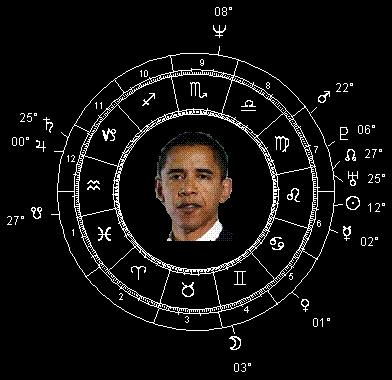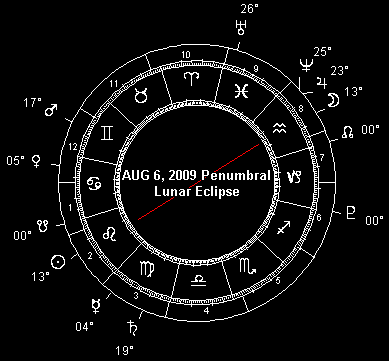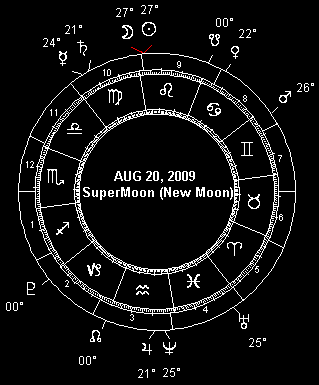If you were expecting some kind of sun sign nonsense, forget about it. This is real astrology for the real world. If it's real astrology for yourself that you want, you can get it by phone or in print. And if you need help deciphering the astrological glyphs in the graphics accompanying this article, see Astroglyphs: Astrological Symbols Guide. Please note: this forecast is expressed in terms of Universal Time (UT). Also please be aware that, while I never change a forecast once it's published, I do post errata to acknowledge typographical errors and the like.
One faces the future with ones past.
-- Pearl Buck
 Another SuperMoon, another eclipse déjà vu all over again? Not quite. July had two eclipses, one of which was a SuperMoon. August has only one eclipse (the lunar eclipse on the 6th), followed by a SuperMoon on the 20th. On top of these two major geocosmic phenomena, theres lots more happening in the August sky including the Sun opposing Jupiter on the 14th and Neptune on the 17th (with Mercury conjunct Saturn that same day). Theres a fair amount of Mars action showing up too: Mars squaring Saturn on the 11th and Uranus on the 19th, and opposing Pluto as well on the 26th. And then theres the Mercury intersolar cycle, which begins on the 24th as the little innermost planet reaches its maximum elongation east of the Sun as seen from Earth. Its a cycle that continues through the September 7-29 retrograde and the September 20 inferior conjunction, ending with Mercurys maximum western elongation on October 6.
Another SuperMoon, another eclipse déjà vu all over again? Not quite. July had two eclipses, one of which was a SuperMoon. August has only one eclipse (the lunar eclipse on the 6th), followed by a SuperMoon on the 20th. On top of these two major geocosmic phenomena, theres lots more happening in the August sky including the Sun opposing Jupiter on the 14th and Neptune on the 17th (with Mercury conjunct Saturn that same day). Theres a fair amount of Mars action showing up too: Mars squaring Saturn on the 11th and Uranus on the 19th, and opposing Pluto as well on the 26th. And then theres the Mercury intersolar cycle, which begins on the 24th as the little innermost planet reaches its maximum elongation east of the Sun as seen from Earth. Its a cycle that continues through the September 7-29 retrograde and the September 20 inferior conjunction, ending with Mercurys maximum western elongation on October 6.
This is the portion of its orbit which puts Mercury on the same side of the Sun as our home planet; and consequently nearer to us. Its a peak Mercury experience, with the little planet shining brighter than usual as the evening star at the beginning of the intersolar phase. And then it gets really strange, when Mercurys apparent motion through our sky slows, then comes to a standstill, and then reverses direction the infamous Mercury retrograde. After a few weeks, the reverse motion slows and stops, and then the little planet resumes its normal course of motion through our sky. Mercury remains brighter than usual following the end of its retrograde cycle, until it reaches maximum elongation west of the Sun (Mercurys morning star phase) and then passes behind the solar plane as seen from Earth.
What I have termed the Mercury intersolar cycle is a way of putting the Earth-Sun-Mercury relationship into a perspective that reflects real-sky, observational astronomy. Look up in the sky over the indicated period and on the specified dates, and you will see the phenomena described above. This perspective replaces the stilted, removed-from-reality practice of looking not at the sky, but at an ephemeris: first to see when Mercury comes to the degree at which it will later makes its direct station, and second when it reaches the degree at which it will later make its retrograde station; and then referring to the overlap between these two dates and the lesser included Mercury retrograde dates as the "shadow period" of the retrograde. For example, the shadow period for the September 7-29 Mercury retrograde would begin on August 17 (the day Mercury reaches the degree at which it goes direct on September 29) and end on October 14 (the day Mercury returns to the degree at which it went retrograde on September 7). But in terms of any organic, visible manifestation in the skies of our home planet, these ephemeris-derived dates have no relevance to the Earth-Sun-Mercury dynamic. Its like left-brain versus right-brain thinking, linear versus holistic. One is a made-up abstraction looked up in a book, the other a reality that can be seen in the sky.
Ive already described the Mercury intersolar cycle in detail elsewhere, so I wont repeat myself here. The animation in this months forecast may help put the phenomenon in perspective. In any event, of more immediate concern is what to expect during this August 24-October 6 cycle. First and foremost, its important to recognize that all things Mercurial are crucial during the intersolar Mercury phase; infrastructure, commerce, information, communication and transport being prime examples. Absent careful investigation and planning, and conscientious follow-through, all such things are apt to go off track during these cycles. Mercury's intersolar phase is a time for focus, concentration, planning, follow-through and communication - all the qualities of the active and involved mind, in short.
In case you hadn't noticed, most people are not especially alert and focused most of the time. When this kind of sleepwalking runs into Mercury's intersolar cycle, with its focus on mental acuity, it doesn't take long for things to go awry. If you're sharp and focused and alert, you can avoid a certain amount of this mess. In fact, you can even prosper by concentrating on tasks that center on thought, planning and communication. But you'll still have to dodge all the chaos created by the people who are sleepwalking. So be ready.
Among the sort of things to be ready for during the above mentioned Mercury intersolar cycles: strikes and other disruptions affecting transportation and communication (e.g. postal, phone, mass transit, trucking, airline, shipping, dock and warehouse workers, teachers and all manner of media). Weather both terrestrial and solar (including geomagnetic storms) can play a part in the kind of breakdowns described here, but human effort (and sometimes malicious action) is a part of the mix as well. Power failures due to infrastructure breakdown and computer network disruptions caused by hacker attacks, software vulnerabilities and the like are also just a crossed wire or a keystroke away from a major mess at these times. Above all, remember this: assuming that other people will be competent and responsible is always risky. Its practically insane during a Mercury intersolar cycle. Follow up and follow through, or just stay home.
 If I had to pick a day to have a backup generator all fueled up and ready to go, a contingency plan in place in case the scheduled or expected didn't come to pass, a day to be especially sharp and steady and focused - it would be during one of these Mercury cycles. It's not so much that disaster is destined to strike when Mercury is in its intersolar phase. Rather, it's that everything pertaining to Mercury becomes crucial; and unless it's treated as such, then it goes awry. More and more, we live in a "just in time" world - and if the slightest delay holds up just one single thing, then a whole process screeches to a halt. Unfortunately, few people keep their eye on the ball with any consistency and diligence. And that's the reason these Mercury cycles tend to turn into Murphy's Law festivals. Practically speaking, this means that having a "just in time" or "sufficient for now" inventory of essentials is risky business at times like this. Don't say I didn't warn you!
If I had to pick a day to have a backup generator all fueled up and ready to go, a contingency plan in place in case the scheduled or expected didn't come to pass, a day to be especially sharp and steady and focused - it would be during one of these Mercury cycles. It's not so much that disaster is destined to strike when Mercury is in its intersolar phase. Rather, it's that everything pertaining to Mercury becomes crucial; and unless it's treated as such, then it goes awry. More and more, we live in a "just in time" world - and if the slightest delay holds up just one single thing, then a whole process screeches to a halt. Unfortunately, few people keep their eye on the ball with any consistency and diligence. And that's the reason these Mercury cycles tend to turn into Murphy's Law festivals. Practically speaking, this means that having a "just in time" or "sufficient for now" inventory of essentials is risky business at times like this. Don't say I didn't warn you!
Mercury antics aside, theres a lot of friction in the air this month; the kind that frays nerves and tempers. Its the sort of ambience that easily turns from tension into outright conflict, whether at the interpersonal or international level. Youll see it most evidently around the dates of the prominent Mars action in August, from a few days before to a few days after the Mars-Saturn square on the 11th, the Mars-Uranus square on the 19th, and the Mars-Pluto opposition on the 26th. (President Obamas chart shows potential personal danger this month, and on into September and October before it eases.) Blessed are the peacemakers at any time, of course but theyre most sorely needed at times like this. These are by no means the most extreme Mars activations of the year, so dont be unduly alarmed. But do stay safety-conscious and focused on what youre doing during the Red Planet days of August.
 The aforementioned Mars-Saturn square is within a few degrees of exact just in time for the August 6 penumbral lunar eclipse, pointing to storm and seismic potential on a planetary scale during this particular eclipse window, which stretches from the 3rd through the 9th. Its worldwide potential aside, there are some rather ominous looking astro-locality indicators of special risk zones for this eclipse. They include a couple longitudinal sectors; one running from west Africa northward to just off the east coast of Iceland, and another running from far eastern Siberia down through New Zealand. Theres also a horizon arc running across Mexico and the western end of the Gulf of Mexico through the Mississippi River basin and across the Great Lakes into Canada, and sweeping across southern Greenland the North Atlantic to cross Scandinavia and Russia down into Afghanistan, Pakistan and India. Remember: theres an elevated worldwide danger from strong storms and moderate to severe seismic activity (including magnitude 5 earthquakes and volcanic eruptions) during this eclipse, so have your emergency stuff ready just in case.
The aforementioned Mars-Saturn square is within a few degrees of exact just in time for the August 6 penumbral lunar eclipse, pointing to storm and seismic potential on a planetary scale during this particular eclipse window, which stretches from the 3rd through the 9th. Its worldwide potential aside, there are some rather ominous looking astro-locality indicators of special risk zones for this eclipse. They include a couple longitudinal sectors; one running from west Africa northward to just off the east coast of Iceland, and another running from far eastern Siberia down through New Zealand. Theres also a horizon arc running across Mexico and the western end of the Gulf of Mexico through the Mississippi River basin and across the Great Lakes into Canada, and sweeping across southern Greenland the North Atlantic to cross Scandinavia and Russia down into Afghanistan, Pakistan and India. Remember: theres an elevated worldwide danger from strong storms and moderate to severe seismic activity (including magnitude 5 earthquakes and volcanic eruptions) during this eclipse, so have your emergency stuff ready just in case.
By far the greater storm and seismic risk window of August is associated with the August 20 SuperMoon, the last of a trio of 2009 new moon SuperMoons. What did its predecessor bring? Only the most powerful earthquake of the year to date, a magnitude 7.7 monster that moved New Zealand a foot closer to Australia on July 15 described in my 2009 World Forecast Highlights as the opening day of an "effective risk window extending from the 15th through the 29th. Strong storms with high winds and heavy precipitation would seem to be a specialty of this alignment: a surge in hurricane, tornado and typhoon activity will be a focus of this particular lunation, although it will have its tidal and seismic components as well. In fact I see plenty to suggest that the risk of magnitude 5+ earthquakes and volcanic eruptions will be a specialty of the July SuperMoon eclipse."
 The August 20 new moon SuperMoon at 27° 32 Leo gives every appearance of indicating particularly strong tidal, storm and seismic events during the August 17-23 SuperMoon stress window. But given a simultaneous combination of other celestial events Mercury conjunct Saturn opposing Uranus, Mars opposing Pluto (and all of these on the meridian at Tehran), and the SuperMoon itself opposing Jupiter and Neptune I think theres a lot more than the geophysical to this one. It comes at a time of mounting interpersonal as well as geopolitical tensions, and increasing dislocations in the worlds economy in general and financial system in particular. Think safety, think security, minimize risk. I mentioned in last months forecast that the July 22 SuperMoon eclipse marked the beginning of a period when major equity markets are wickedly vulnerable; culminating around the time of the "next (and central) alignment in the current Saturn-Uranus opposition series, on September 15".
The August 20 new moon SuperMoon at 27° 32 Leo gives every appearance of indicating particularly strong tidal, storm and seismic events during the August 17-23 SuperMoon stress window. But given a simultaneous combination of other celestial events Mercury conjunct Saturn opposing Uranus, Mars opposing Pluto (and all of these on the meridian at Tehran), and the SuperMoon itself opposing Jupiter and Neptune I think theres a lot more than the geophysical to this one. It comes at a time of mounting interpersonal as well as geopolitical tensions, and increasing dislocations in the worlds economy in general and financial system in particular. Think safety, think security, minimize risk. I mentioned in last months forecast that the July 22 SuperMoon eclipse marked the beginning of a period when major equity markets are wickedly vulnerable; culminating around the time of the "next (and central) alignment in the current Saturn-Uranus opposition series, on September 15".
As for the geophysical drama the storms, the tidal surges, the up-tick in moderate-to-severe earthquakes and volcanic activity theres no place on Earth beyond the reach of one or more of these manifestations. Wherever you are, its prudent to have your emergency kit and preparations ready just in case. If youre going to be on the move during this SuperMoon, at least take the possibility of weather delays into consideration . . . maybe most especially if youll be in one of the astro-locality hot zones for this alignment. These include a longitudinal sector from Hawaii through Alaska in the New World, and from Eastern Europe down through east central Africa in the Old. There are also horizon arcs through eastern Canada and the northeastern US, sweeping across Venezuela and Brazil in South America to emerge on the other side of the world and crossing from Western Australia over Indonesia, the Philippines, east China and Japan onward to eastern Siberia. And then there are those multiple meridian arcs at Tehran . . .
In closing, be ready for more "Freaky Fridays" the day US regulators seize failing banks. I know its fashionable to believe that the so-called "Great Recession" the longest US economic downturn since official statistics were kept is over or nearly over: and the sooner the better, I say. Certainly it will end someday. But what I see, as Ive said before, looks like a "W or double-W" recovery curve. This isnt an ordinary recession. Its a turning point in history comparable to the beginning of the Industrial Revolution and the system of finance capitalism that enabled it. If youre looking for business as usual, look over your shoulder.
 SPECIAL FEATURE: This month's birthdays of the famous and infamous (with astrological birth charts)
SPECIAL FEATURE: This month's birthdays of the famous and infamous (with astrological birth charts)